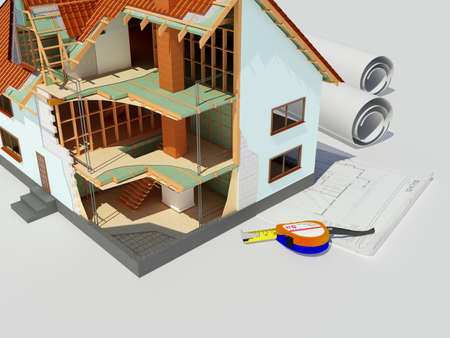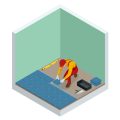Introduction to Your Home’s Electrical System
Understanding the basics of your homes electrical system can help you stay safe, identify problems, and communicate more effectively with electricians. Most American homes follow a standard setup when it comes to electricity. This includes a main service panel (also called a breaker box), individual circuits for different areas or appliances, and a network of wires that run throughout the house.
Main Components of a Home Electrical System
Your homes electrical system is like the nervous system of your house—constantly working behind the scenes. Here are the key parts:
| Component | Description |
|---|---|
| Main Service Panel | This is the central hub where electricity enters your home from the utility company. It contains circuit breakers that control power to different parts of the house. |
| Circuits | Circuit breakers divide electricity into different paths or “circuits” for each room or appliance. If there’s an overload, the breaker trips to prevent damage or fire. |
| Wiring | Wires carry electricity from the panel to outlets, switches, and fixtures. These include hot wires (black or red), neutral wires (white), and ground wires (green or bare). |
How Electricity Flows in Your Home
Electricity comes into your house through overhead or underground lines and goes straight to the main service panel. From there, it’s distributed through various circuits that power everything—from your kitchen lights to your living room TV. Each circuit is protected by a breaker that helps avoid overheating and potential fires.
Typical Circuit Examples in American Homes:
| Area/Appliance | Circuit Type | Breaker Size (Amps) |
|---|---|---|
| Lighting and Outlets | General-purpose circuit | 15-20 amps |
| Kitchen Appliances | Dedicated circuits | 20 amps |
| Clothes Dryer | 240V dedicated circuit | 30 amps |
| HVAC System | High-load dedicated circuit | 30-50 amps |
The Importance of Grounding
A properly grounded electrical system protects both people and devices. It ensures that if something goes wrong—like a wire coming loose—the excess electricity will safely travel into the ground instead of causing injury or damage.
Staying Safe Around Electricity
If youre ever unsure about something electrical in your home, its always best to call a licensed electrician. Never try to repair wiring unless you’re trained—it can be dangerous. Knowing what each part does, though, gives you more confidence when dealing with basic issues or planning upgrades.
This basic introduction sets the stage for understanding how your homes electrical system functions day-to-day. In upcoming sections, we’ll dive deeper into wiring types, safety tips, and how to troubleshoot common problems.
2. The Main Service Panel and Circuit Breakers
Your home’s electrical system starts at the main service panel, often called the breaker box. This is where electricity from your utility company enters your home and gets distributed to different circuits. Understanding how this panel works can help you stay safe and troubleshoot simple electrical issues.
What Is the Main Service Panel?
The main service panel is usually a gray metal box mounted on a wall in a garage, basement, or utility room. Inside, you’ll find a series of circuit breakers that control power to different areas of your home. Each breaker is like a switch that can turn off electricity to a specific circuit when there’s a problem.
Common Locations for the Breaker Box:
| Location | Description |
|---|---|
| Garage | Easily accessible and common in newer homes |
| Basement | Often found in older homes |
| Laundry Room/Utility Room | Sometimes located near water heaters or furnaces |
How Circuit Breakers Work
Circuit breakers are safety devices designed to prevent electrical overloads and potential fires. When too much current flows through a circuit—like when too many appliances are plugged in—the breaker will “trip,” cutting off the power to that area.
Signs That a Circuit Breaker Has Tripped:
- No power in part of the house (like lights or outlets not working)
- A breaker switch has moved to the middle or “off” position
- You may hear a click or pop when it trips
How to Safely Reset a Tripped Breaker
If a breaker trips, you can usually reset it yourself by following these simple steps:
- Locate your main service panel.
- Find the breaker that’s in the “off” or middle position.
- Firmly switch it all the way to “off,” then back to “on.”
If the breaker trips again right away, don’t force it. There may be an underlying issue that needs attention from a licensed electrician.
Understanding how your main service panel and circuit breakers work gives you more control over your homes safety and functionality. Its one of the first steps toward becoming more confident with basic home maintenance.
![]()
3. Understanding Electrical Wiring and Outlets
When it comes to your homes electrical system, wiring and outlets are the backbone of how electricity flows throughout each room. Whether youre plugging in a toaster or flipping on a light switch, youre interacting with a network of wires and devices that keep everything running smoothly. Heres a simple breakdown to help you understand the basics.
Common Types of Electrical Wiring
Different types of wiring are used in homes depending on their age, location, and the purpose of the circuit. Here’s a quick look at some common residential wiring types:
| Wiring Type | Description | Common Uses |
|---|---|---|
| NM Cable (Non-Metallic Sheathed) | Also known as Romex, this is the most common type used in modern homes. It has plastic sheathing and contains two or more insulated conductors. | Interior walls, outlets, switches, lighting |
| BX Cable (Armored Cable) | This type has a flexible metal sheath around the wires for added protection. | Older homes, exposed areas where extra protection is needed |
| UF Cable (Underground Feeder) | A waterproof version of NM cable designed for underground or damp locations. | Outdoor lighting, garden power supply |
| THHN/THWN Wire | Single-conductor wires often pulled through conduit; resistant to heat and moisture. | Circuit breakers, garage or basement installations |
The Role of Outlets and Switches
Your outlets and switches are the access points to your electrical system. They allow you to control and use the electricity flowing through your home safely and conveniently.
Outlets (Receptacles)
- Standard 120V Outlets: These are the most common in U.S. homes and are used for lamps, TVs, phone chargers, etc.
- GFCI Outlets: Required by code in kitchens, bathrooms, garages, and outdoor areas. They protect against electric shock by shutting off power when they detect a ground fault.
- AFCI Outlets: These detect arc faults from damaged wiring and prevent potential fires. Often required in bedrooms and living rooms.
Switches
- Single-Pole Switch: Controls one light or fixture from one location—simple on/off function.
- Three-Way Switch: Allows you to control the same light from two different locations—great for stairways or large rooms.
Circuit Connections: How Everything Comes Together
Your homes electrical wiring connects all switches and outlets back to your circuit breaker panel. Each circuit is designed to handle a specific amount of load (usually 15 or 20 amps), so understanding how many devices can be plugged in without tripping a breaker is key to safety and efficiency.
If youre planning any upgrades or renovations involving electrical work, its essential to know what kind of wiring you have and how your circuits are laid out. When in doubt, always consult with a licensed electrician who can ensure everything is up to code and functioning properly.
4. Common Electrical Safety Tips for Homeowners
Understanding basic electrical safety can help prevent accidents, protect your home, and even save lives. Whether youre flipping a breaker or plugging in appliances, following a few simple rules will go a long way. Here are some essential tips every homeowner should know.
Know When to Call a Licensed Electrician
Some electrical tasks are best left to the pros. While changing a light bulb or resetting a tripped breaker is fine for most homeowners, more complex jobs require the expertise of a licensed electrician. Use the table below to help you decide when its time to call in professional help:
| Situation | DIY Safe? | Call an Electrician? |
|---|---|---|
| Resetting a tripped circuit breaker | ✔️ | ❌ |
| Replacing a light switch or outlet cover | ✔️ (if power is off) | ❌ |
| Installing new outlets or fixtures | ❌ | ✔️ |
| Upgrading your electrical panel | ❌ | ✔️ |
| Flickering lights or burning smell from outlets | ❌ | ✔️ (Urgent!) |
Watch for Warning Signs of Electrical Problems
Your home may give you clues when somethings wrong with the wiring. Pay attention to these signs:
- Sparking outlets: This could mean loose wiring or faulty components.
- Circuit breakers that trip often: May indicate overloaded circuits or short circuits.
- Burning smell near outlets or switches: Turn off power immediately and call an electrician.
- Buzzing sounds from walls or panels: Could suggest arcing wires — a serious fire hazard.
- Dimming or flickering lights: Might be due to poor connections or overloaded circuits.
Everyday Electrical Safety Habits
A few good habits can make your home much safer. Keep these practices in mind:
- Avoid overloading outlets: Plug only one high-wattage appliance into each outlet.
- Use extension cords temporarily: They are not meant for permanent use.
- Keep cords in good condition: Replace frayed or damaged cords right away.
- Childproof your outlets: Use tamper-resistant covers if you have young kids.
- Unplug unused appliances: Reduces fire risk and saves energy.
- Avoid running cords under rugs or furniture: This can cause overheating and wear down insulation.
Create an Emergency Plan
If something goes wrong, knowing what to do can make all the difference. Make sure everyone in your household knows where the main breaker panel is located and how to shut off power in an emergency. Keep emergency numbers handy and install smoke detectors near bedrooms and major appliances.
Your Quick Safety Checklist:
- Main breaker labeled and accessible ✅
- No overloaded outlets ✅
- Cords in good condition ✅
- No unusual smells, sparks, or sounds ✅
- A licensed electrician checks system every few years ✅
Your homes electrical system works hard every day — keeping it safe doesn’t have to be complicated. By staying alert and knowing when to call in a pro, you’re taking smart steps toward protecting your family and property.
5. When to DIY and When to Call a Pro
Understanding your homes electrical system doesnt mean you need to become an electrician overnight. But knowing what you can safely do yourself—and what should be left to licensed professionals—can save you time, money, and help avoid dangerous mistakes.
Safe DIY Electrical Tasks
Some simple electrical jobs are generally safe for homeowners with basic knowledge and the right tools. These tasks usually don’t involve direct interaction with live wires or major system components. Here are a few examples:
| DIY-Friendly Task | Description |
|---|---|
| Replacing Outlet Covers | This is purely cosmetic and doesnt involve touching any wiring. |
| Changing Light Bulbs | A basic task that doesn’t require any special tools or knowledge. |
| Installing Battery-Operated Smoke Detectors | No wiring involved; just follow the instructions provided by the manufacturer. |
| Tightening Loose Outlet Screws or Switch Plates | If the power is off, tightening these with a screwdriver is safe and easy. |
| Replacing a Light Fixture (Same Wattage & Location) | If youre just swapping out an old fixture for a new one in the same spot, this can be done carefully with the power turned off. |
Tasks That Require a Licensed Electrician
If youre dealing with anything more complex than whats listed above, its best to call in a professional. Electricity is dangerous, and improper work can lead to fire hazards, code violations, or serious injury. Here are situations where hiring an electrician is strongly recommended:
- Additions or changes to wiring: Running new wires through walls or ceilings requires permits and must meet local codes.
- Circuit breaker installation or replacement: This involves working directly with your main electrical panel—a risky job even for experienced DIYers.
- Addition of new outlets or switches: While it may seem simple, this often involves tapping into existing circuits correctly and safely.
- Troubleshooting frequent circuit trips: This could indicate deeper issues like overloaded circuits or faulty wiring.
- Kitchens and bathrooms upgrades: These areas have special rules due to moisture risks and typically require GFCI outlets and careful grounding.
Your Safety Checklist Before Any DIY Task
If youre planning on tackling a small electrical project, always go through this quick checklist first:
- Turn Off Power: Use your breaker panel to shut off electricity to the area youre working on.
- Test Wires: Use a voltage tester to confirm no electricity is flowing before touching anything.
- Avoid Wet Areas: Never work on electrical components near water unless youre trained and using proper protection.
- No Aluminum Wiring: Homes built in the 1960s–70s may have aluminum wiring, which needs special handling—call a pro if you suspect this.
- If Unsure, Don’t Do It: When in doubt, it’s always safer (and often cheaper in the long run) to hire a licensed electrician.
The bottom line: while there are some electrical projects that confident homeowners can handle safely, many others require professional training and licensing. Respecting these boundaries helps keep your home safe and up to code.


